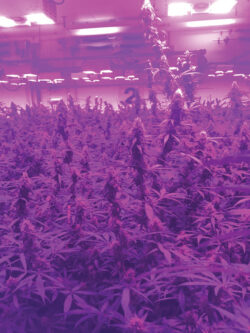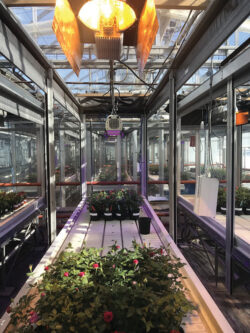
Features
Supplemental lighting
Some practical considerations when choosing lighting for greenhouse floriculture production.
August 9, 2022 By David Llewellyn and Dr.Youbin Zheng
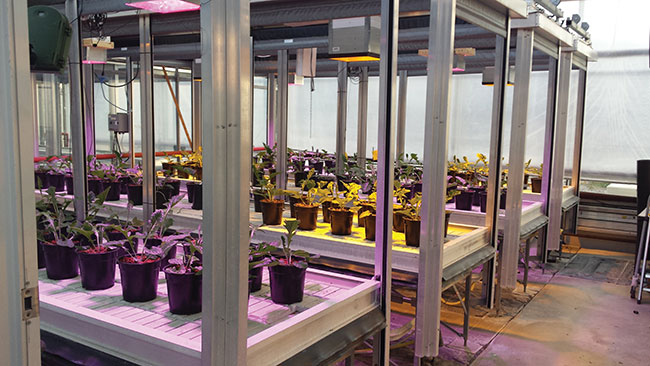 Electrical lighting technologies have been used for decades for supplementing PAR during
periods of low natural lighting to increase
photosynthesis and growth. Photo by David Llewellyn, University of Guelph.
Electrical lighting technologies have been used for decades for supplementing PAR during
periods of low natural lighting to increase
photosynthesis and growth. Photo by David Llewellyn, University of Guelph. How plants use light and how cultivators use supplemental lighting
Plants utilize their lighting environments in three main ways: 1) as the source of photosynthetic energy (i.e., PAR, 400-700nm) that drives plant growth, 2) as timing cues that moderate different life phases (e.g., germination, transition from vegetative to flowering), and 3) as environmental cues that modify plant structure to optimize the capture and utilization of PAR.
Through a complex array of photoreceptors, plants can sense the light intensity [e.g.., photosynthetic photon flux density (PPFD), daily light integral (DLI)], photoperiod, and spectral quality and respond in ways to optimize their chances of survival and reproductive success. Greenhouse growers can manipulate the lighting environment to leverage the fundamental ecological characteristics of their commodities to produce flowering plants with preferred structure, size, and flowering responses.
Electric lighting technologies have been used for decades for supplementing PAR (i.e., assimilation lighting) during periods of low natural lighting to increase photosynthesis and growth. Low intensity electric lighting are also used to manipulate the timing of flowering responses in photoperiodic crops – either for promoting or delaying flowering – using strategies such as day extension and night interruption. Some cultivators also propagate crops in high-density indoor nursery systems; these systems rely entirely on electric lighting technologies as the sole source of PAR.
Contemporary and modern horticultural lighting technologies
High pressure sodium (HPS) lighting has been the standard electric lighting technology for assimilation lighting in greenhouses for decades, normally providing canopy PAR levels ranging from 50 to 200 µmol·m-2∙s-1. Since photoperiod signals require much lower intensity levels, incandescent and compact fluorescent bulbs have often been used for photoperiodic lighting. The high cropping density (often multi-layer) and low light levels required in sole-source propagation systems have traditionally used fluorescent tube lighting.
The popularity of horticultural light emitting diode (LED) technologies continues to grow exponentially due to their promise of high efficiency, long life, dimmability, and spectrum tuneability. This article will discuss some of the most likely scenarios where the special capabilities of LED technologies could be best leveraged to replace legacy technologies in plant production systems, especially floriculture production systems. Some critical and practical considerations will help growers in choosing the optimum lighting for their operations.
Supplemental lighting in propagation: Light spectrum may not be that important
While it comprises a small component overall production area, propagation can have a disproportionately large influence on finished crop quality because they start with healthy transplants. Therefore, propagation is an important component of your business to focus on when considering supplemental lighting.
We have conducted lighting research, both in greenhouses and indoor environments, that investigated the effects of light spectrum on stock plants, vegetative propagation, and seed germination of floriculture crops as well as spectrum and intensity experiments on leafy vegetables (e.g., microgreens, pea shoots) and cannabis.
Supplemental lighting from both HPS and LED improve rooting of cuttings, however there was little evidence to distinguish between spectrums for the production of rooted cuttings in greenhouse environments. While spectrum effects are more common in indoor environments, we found that these effects are greatly muted in greenhouses. The natural light imposes a strong spectrum dilution making it difficult to induce spectrum responses. From the results of these studies, combined with our previous studies on LED vs. HPS in cut flower production and many other studies by other research groups (e.g., Llewellyn et al., 2020a; Martineau et al., 2012; Poel and Runkle, 2017) we conclude that using LED and HPS technologies in greenhouses should result in similar production outcomes in terms of crop size and quality.
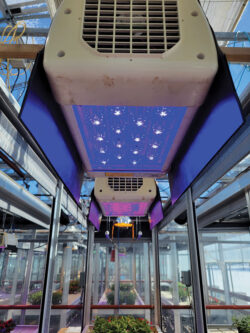
Comparing different LED spectrums (foreground) with HPS (background) for the production of potted ornamentals. Photo by David Llewellyn, University of Guelph.
Energy efficiency of LED vs HPS
The question of what lighting is best for a given production facility may boil down to fixture costs (over their lifetime) and energy usage. For an equivalent photon flux, the purchase price of HPS technologies is still definitely cheaper than LEDs, however the price gap continues to narrow. Rebate programs are available in many jurisdictions to help offset the cost of energy-efficient LED technologies. Where LEDs can outcompete HPS is the lifetime cost; or the so-called return on investment (ROE).
With the broad variety of form factors of different horticultural lighting technologies, it is important to standardize their overall efficiency for converting electricity into PAR to ensure direct comparisons are being made. This parameter is called efficacy, which has units of µmol·J-1.
Recent advances have improved HPS efficacy by about 60 per cent since the turn of the century (Nelson and Bugbee, 2014). Modern double-ended HPS fixtures with electronic ballasts can achieve efficacies of around 1.7 µmol·J-1 (Radetsky, 2018) which is close to the maximum achievable efficacy of HPS technology.
In contrast, LED efficacy is still rapidly increasing. Most horticultural LEDs are combinations of three LED types: blue (B, peaking in the 450nm range), red (R, peaking in the 660nm range) and white (W) LEDs which are B LEDs plus a yellow phosphor layer that broadens the emitted wavelengths. The spectrum from all white LEDs have a B peak followed by a much broader peak in the green (G, 500-600nm) and R wavebands. Figure 1 shows the spectrum of two types of W LEDs. The 5000 K “cool” LED has less phosphor conversion, thus a relatively larger B peak than the 3000 K “warm” LED. Naturally, internal losses in white LEDs reduce their efficacy below the base B LED – normally the large the B peak in the W LED spectrum, the higher the efficacy. The more general trend for LED efficacy is R > B > W, partly because R photons contain about 30 per cent less energy than B, thus less electrical energy is needed to produce R vs. B photons. However, due to the ubiquity of B LEDs in white occupant lighting applications, B and W LEDs are often several times cheaper than R LEDs.
A major caveat that is not often discussed is the relationship between LED spectrum and efficacy in modern horticultural LEDs. Manufacturers tend to blend different LED types to strike a balance between diode cost, the colour perception of the emitted light, and energy efficiency. Generally, the higher the efficacy, the lower the colour-rendering and the more magenta (or ‘blurple’) appearance of the spectrum. The Design Lights Consortium publishes a detailed list of qualified horticultural LEDs whose design and performance meet a specific criteria. One major criterion is a minimum PAR efficacy of 1.9 µmol·J-1 (soon to be raised to 2.3 µmol·J-1). To contextualize how spectrum affects efficacy, Figure 2 shows relationship between percent red and efficacy of some DLC-qualified products. The colored ovals arbitrarily separate the spectra into three distinct groups, with typical spectra of each group illustrated in inset graphics. The spectrum distribution from the lowest efficacy group (blue oval) comes primarily from W LEDs, with a minor proportion from R. Conversely, the spectrum from the highest efficacy group (pink oval), comes primarily from R LEDs, with a minor proportion (normally five to 20 per cent) from B. The magenta-appearance of these B+R spectra have poor colour rendering, making it difficult to evaluate crop health during periods of low natural lighting. The middle grouping (green oval) is a combination of these extremes and – naturally – has intermediate efficacy levels and appearance. These spectrums normally have a pinkish-whitish appearance with decent colour-rendering.
Modern LEDs certainly have higher efficacy values than legacy lighting technologies. There are currently over 600 different products listed on the DLC; almost 400 of them have efficacies ≥ 2.5 µmol·J-1 and more than 10 are more than twice as efficient as HPS. Suffice it to say that there are plenty of LED options available for the savvy greenhouse grower to choose from to suit the needs of any production system.
Considering the broad range of efficacy values for different LEDs, it is difficult to generalize how much more energy efficient LEDs are vs. HPS – it depends on the choice of LED fixture. Soon, every DLC-listed fixture will be at least 1.4 times more efficient than the best HPS. With all other things being equal (e.g., light distribution), the higher efficacy of LEDs should directly translate to the reductions in “installed wattage” (e.g., # of fixtures per hectare × fixture wattage) that will be required for a given canopy PPFD.
A handy, but not altogether accurate, way of estimating the number of fixtures and the installed wattage for any given production scenario only needs a few basic values:
- The production area in m2;
- The target supplemental PPFD in this area, in µmol·m-2·s-1;
- The prescribed total photon flux of the fixture of interest, in µmol·s-1.
The number of fixtures needed to achieve the target PPFD in that area is equal to: (#1 x #2) ÷ #3. Further, multiplying the number of fixtures by their input wattage will estimate total power draw (i.e., installed wattage). Note that this is an ideal scenario that assumes that all produced PAR photons will reach your crops, with no wastage. This never happens in real life because it doesn’t account for fixture positioning (in 3-d space), light distributions patterns, reflectivity of hard surfaces, edge effects etc., but it is still a useful exercise to estimate how many fixtures of a given type are needed. It can also help to quickly assess and compare light plans from lighting vendors.
Another often unmentioned concept is what happens to the electrical energy that you’re putting into lighting. Some of that energy obviously goes towards producing PAR photons with the rest emitted as heat. However, only about five to 10 per cent of the emitted PAR is converted into plant biomass through photosynthesis (Bugbee and Salisbury, 1988). Much of the absorbed light energy is converted into latent heat by evaporating water from the leaves through transpiration. Therefore, when determining the contributions of supplemental lighting to energy flux in the greenhouse environment, it is advisable to assume that all of the electrical energy input for lighting will eventually converted into some form of heat, irrespective of the lighting technology.
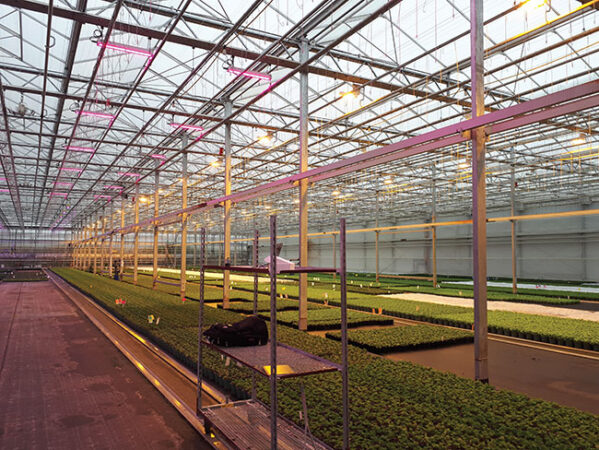
Commercial field trial comparing the propagation of various ornamental crops grown under supplemental red and blue LED (left) and HPS (middle) to an unlit control (far right).
HPS vs LED: beyond efficacy
While HPS has been touted as having greater potential for increasing crop canopy temperatures, this may be beneficial in some circumstances but negative in others. Regardless, converting electricity into heat is a relatively expensive way to maintain temperatures in greenhouse environments. LEDs have myriad advantages over legacy lighting technologies for supplementing PAR in greenhouses, including:
- Two to four times longer lifespans, with photon maintenance levels normally exceeding 90 per cent over their lifespan.
- Better control over photon distribution patterns, which results in much greater flexibility in fixture shapes. This allows for the long and narrow LED fixtures which can be hung directly below super-structure elements, greatly minimizing the shadows cast by supplemental lighting fixtures.
- LEDs are inherently dimmable and can withstand many duty-cycles without negative effects. This enables feedback-control algorithms to manage LED intensity relative to natural lighting conditions, in real-time. The maintenance of stable lighting environments throughout the day can optimize crop light use efficiency while minimizing energy use at times when supplemental lighting is not needed (Llewellyn et al., 2020).
- Cultivators can select an ideal fixed LED spectrum or, in some fixtures, tune the spectral output over time (e.g., throughout the day, at nighttime, or during different production stages).
Final thoughts on what lighting to choose for your greenhouse
More light usually improves crop yield and quality and/or shortens production time, especially during the darker months (Llewellyn et al., 2020b). The optimum amount of supplemental lighting depends on many factors including the types of crops you grow, the amount of natural light available during the critical seasons, and how much you can afford – both up front and electricity.
While LEDs continues to get cheaper, the cost for good quality LEDs from reputable companies is still several times higher than HPS. Leveraging the lower electricity usage of LEDs to make back that return on investment depends on too many factors to generalize. ROE’s can range from a few years to over a decade in different scenarios. While efficacy and spectrum considerations are relatively straightforward, other factors such as distribution uniformity (i.e., where the light actually goes), your contract with the electricity supplier, government rebates, costs of installation and ongoing maintenance, fluctuating commodity prices, etc. can make the ROE calculations hard to predict.
Many lighting vendors will provide side-by-side comparisons of their technology versus ‘the other guys’ (whoever they happen to be) to help push their products. These are often based on idealized scenarios which can have hidden factors – such as the reflectivity of hard surfaces and the amount of stray light around the edges of the target growing area – that can be difficult to fully understand. Before purchasing a lighting solution, scrutinize the light plans and ROE models, ask questions, compare numbers with other vendors, and share your thoughts and findings with other industry folks that you trust. You may not get objective responses, but different points of view can still help you make the best decision for your operation.
Overall, we believe that LED technologies are the future for efficient, long lasting, and high quality horticultural lighting, regardless of the application.
The Design Lights Consortium website (https://www.designlights.org/horticultural-lighting/) is a great source of up-to-date information on the top-performing horticultural LED lighting systems allowing easy evaluations of the performance characteristics of different fixtures. Key product features are easily filtered for selecting appropriate fixtures, such as: form factor, type of cooling, dimmability, spectrum tuneability, temperature range, spectrum ratios (including presence of far red), and input power. The minimum qualifications to be listed will increase within the next year, including a 20-per-cent increase in the minimum efficacy and the absolute necessity that products are dimmable.
One final point of caution. LED companies often manufacture and sell several fixture variants within a single product line. These variants may combine different spectral combinations and input power ratings to suit the needs of a variety of greenhouse facilities. It is quite common for vendors to highlight rated efficacies in terms of “up to” a certain value, which will of course be the most efficient variant. Each fixture variant should have a separate DLC listing where you can independently match the efficacy with the spectrum. If you are considering LEDs that are not on the DLC – and vendors may give myriad reasons for this – use caution when evaluating their proffered efficacy ratings. These ratings can be inflated by unscrupulous vendors by only indicating the efficacy of the bare LEDs while ignoring other inherent fixture-level losses, which can reduce total efficacy by as much as 30 per cent (Kusuma et al, 2020). You may be able to use DLC-listed fixtures with similar spectra (e.g., the inset images in Fig. 4) to assess how realistic a given vendor’s claims may be.
The rapid improvements in LED technology and product development, concurrent reductions in price, and growing body of scientific research have made it clear that LEDs are the future of horticultural lighting. While there are now myriad options to choose from, entities such as the DLC can assist growers in selecting the best lighting system for their individual needs.
References
- Bugbee B. and Salisbury F. (1988) Exploring the limits of crop productivity. Plant Physiol. 88:869-878.
- Design Lights Consortium, Horticultural Qualified Product List, https://www.designlights.org/horticultural-lighting/search/ (accessed on 12 April, 2022).
- Kusuma P., Pattison P.M., and Bugbee B. (2020) From physics to fixtures to food: current and potential LED efficacy. Hortic Res 7, 56. https://doi.org/10.1038/s41438-020-0283-7.
- Llewellyn D., Schiestel K., and Zheng Y. (2019) Light-emitting diodes can replace high-pressure sodium lighting for cut gerbera production, HortScience. 54:95-99.
- Llewellyn D., Lindqvist J., and Zhen, Y. (2020a) How intelligently controlled LEDs can be used to more efficiently manage supplemental lighting in greenhouse production systems. Acta Hortic. 1271:127-134
- DOI: 10.17660/ActaHortic.2020.1271.18.
- Llewellyn D., Schiestel K., and Zheng Y. (2020b) Increasing levels of supplemental led light enhances the rate flower development of greenhouse-grown cut gerbera but does not affect flower size and quality. Agronomy. 10. 1332. 10.3390/agronomy10091332.
- Martineau V., Lefsrud M., and Nanzin M.T. (2012) Comparison of light-emitting diode and high-pressure sodium light treatments for hydroponics growth of Boston lettuce. HortScience. 47:477-482.
- Nelson J. and Bugbee B. (2014) Economic analysis of greenhouse lighting: light emitting diodes vs. high intensity discharge fixtures. PLoS ONE 9, e99010.
- Poel B.R. and Runkle E.S. (2017) Seedling growth is similar under supplemental greenhouse lighting from high-pressure sodium lamps or light-emitting diodes. HortScience. 52:388-394.
- Radetsky L. C. (2018) LED and HID horticultural luminaire testing report. http://www.lrc.rpi.edu/programs/energy/pdf/HorticulturalLightingReport-Final.pdf (accessed on 12 April, 2022).
- Randall W. and Lopez R.G. (2014) Comparison of supplemental lighting from high-pressure sodium lamps and light-emitting diodes during bedding plant seedling production. HortScience .49:589–595.
This article was funded in part by the Canadian Ornamental Horticulture Alliance (COHA-ACHO) and by the Government of Canada under the Canadian Agricultural Partnership’s AgriScience Program. We thank Plusrite Hortscience for their financial support as well.
David Llewellyn has a M.Sc. in horticulture and has been a researcher for many years at the University of Guelph. Dr. Youbin Zheng is a professor at the University of Guelph.
Print this page


